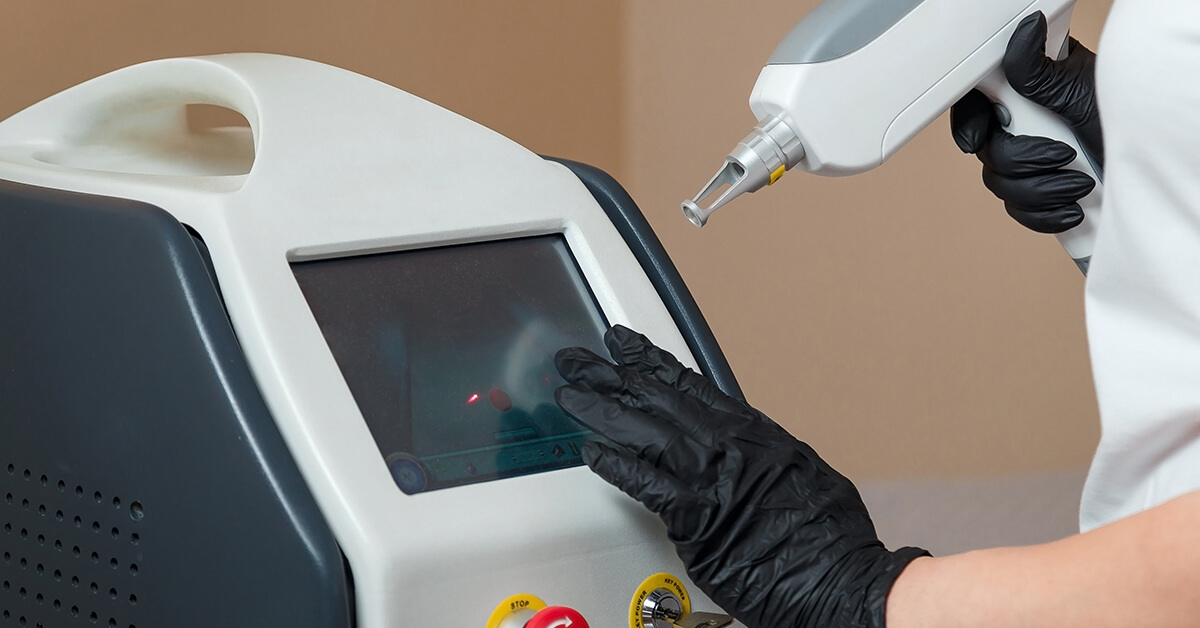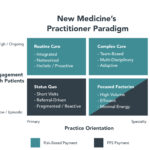May 12, 2022

Overcoming Medical Orthodoxy (Part 3): Forces Disrupting “Old Medicine”
Author Note: This is the third article in a four-part series on reimagining American medical education and ongoing clinician training. Part 1 details the limitations of the current models in training doctors to combat chronic disease and practice value-based care. Part 2 illustrates innovative approaches to training medical professionals through the lens of four new medical schools. Part 3 identifies several powerful that are disrupting established medical practices and paving the way for “New Medicine’s” emergence. Part 4 explores strategies for enhancing clinicians’ capabilities to practice value-based care and population health medicine.
On September 20, 2021, the Cleveland Clinic and management consulting firm Korn Ferry announced the launch of a joint venture designed “to educate and train tomorrow’s physician-leaders and healthcare executives.” Channeling their inner Steve Jobs, the organizations want to develop healthcare leaders that challenge their organizations and one another “to think and act differently.” [1]
The Clinic’s vision is to train and coach healthcare leaders to “develop a stronger sense of who they are and what they bring to the organization, helping to accelerate flexibility, innovation and a new approach to leadership in a world impacted by the pandemic.” In the process, the Clinic aims to “cultivate a strong, supportive organizational culture that increases performance, engagement and retention.”
Implicitly, the joint venture acknowledges that healthcare’s “Old Medicine” culture, business practices and business models are not getting the job done. Under fee-for-service (FFS) medicine, America’s clinicians are not delivering the value-based care and population-health services that consumers desperately need and the marketplace is increasingly demanding.
The Clinic’s initiative is “New Medicine” in action. Healthcare is in desperate need of a more inclusive, collaborative, flexible, innovative and empathetic clinician leaders. Reinventing continuing medical education (CME) could turbocharge incumbents’ efforts to retool their workforce to practice New Medicine. Time is not on their side.
The American public and the broader healthcare ecosystem are not waiting for clinicians, hospitals and health systems to see the light. New business models are emerging to solve consumers’ changing health and healthcare needs. New regulations and payment models incentivize value-based care delivery and broader population health.
Old Medicine cannot evolve, however, without first looking inward and correcting its own faults. Embracing New Medicine requires overcoming counter-productive and deeply ingrained beliefs and behaviors that shape organizational cultures. Never has the biblical admonition for clinicians to “heal thyselves” been more necessary.
The Inadequate Status Quo
Old Medicine has created a “superstar” physician marketplace that rewards individual achievement and discourages team-oriented behaviors. It lacks standardization, avoids accountability and delivers suboptimal care outcomes. It grants enormous autonomy to physicians, supports hierarchical command-and-control management systems and discourages innovation.
 As a result, fragmentation in care delivery occurs, communication suffers, workarounds abound, and status-quo practices predominate. These archaic and counterproductive behaviors are endemic. Their perpetuation compromises patient safety and care outcomes.
As a result, fragmentation in care delivery occurs, communication suffers, workarounds abound, and status-quo practices predominate. These archaic and counterproductive behaviors are endemic. Their perpetuation compromises patient safety and care outcomes.
Nurses and support professionals bring aligned and deep skillsets to medical teams. Unfortunately, command-and-control leadership models suboptimize their contributions. Hierarchical operations too often box clinicians of all stripes into mechanistic roles that discourage teamwork, information-sharing and dynamic responsiveness.
The all-powerful, all-knowing physician archetype is a relic of a bygone era. Healthcare technologies often contribute to suboptimal clinical outcomes. Excessive administrative tasks, operational inconsistencies and restrictive regulations pull clinicians away from patient beds and prevent healthcare professionals from practicing at the top of license.
CME Perpetuates Status Quo
Continuing medical education (CME) should be a tool to advance New Medicine, but it largely fails to do so. State medical boards require 20-50 hours of approved CME credits per year. The Accreditation Council for Continuing Medical Education (ACCME) is the sole accrediting body for continuing medical education. According to ACCME, the healthcare industry spent $3 billion on CME programming in 2019.
Registration fees accounted for 55% of that total. Commercial support and advertising, primarily from pharmaceutical companies, accounted for 41%. Private donations and government grants accounted for the remaining 9%. The high level of commercial support for CME introduces the question of whether sponsorship curtails educational programming that advances high-value care delivery.
Despite the ACCME’s strategic objective of promoting team-based education and addressing public-health priorities, CME programming is largely proforma, ad hoc, user led, process driven and disconnected from operations. Granting certificates satisfies a professional development requirement but doesn’t translate into better clinical-care outcomes or customer experience.
Like so much in healthcare, current models for CME support the Old Medicine status quo and the system’s hierarchical, treatment-centric orientation. The deficiencies of physician-centric care delivery with limited interdisciplinary and interprofessional coordination are obvious. More of the same approach to CME will yield more of Old Medicine’s dismal outcomes.
Fortunately, Old Medicine is under attack on multiple fronts. Rising consumerism means less tolerance for substandard business practices. Powerful demographic and market forces demand higher performing workforces. Consequently, New Medicine clinicians treat disease more effectively, prevent disease more consistently and promote health continuously.
Relentless Demographics, Changing Consumer Demand
U.S. healthcare is on the cusp of massive demographic shifts that will alter the composition of the industry’s future workforce. The dynamics of those receiving care and the speed with which organizations adapt to technology-enabled digital imperatives will shift dramatically in response. By 2025, Millennials (Gen Y and Gen Z) will represent 64% of the U.S. workforce. The long-dominant Baby Boomer workforce percentage will drop to only 8%.
Demographics are destiny. Millennials are redefining the modern workplace. They have very different beliefs than Boomers regarding communications, privacy, hierarchy and organizational primacy. Most millennials rely on individualized algorithms to shape their economic and social interactions. They connect through imagery, including video, more than words, while twitter and text comprise their word-based communication. They are diverse, confident, multimodal and collaborative. Educational and training programs must evolve to meet their expectations and preferences.
Boomers and Millennials are advancing healthcare consumerism from both ends of the demographic spectrum. As they age into their golden years, Boomers will constitute an increasing share of the population receiving healthcare services. Boomers are not going quietly into that good night. They are signing up in record numbers for Medicare Advantage programs tailored to their preferences. They’re refusing to let others dictate their elder care. Like they always have, Boomers are demanding attention and redefining service provision.
The oldest Millennials are now in their early 40s. Despite contradicting studies about their use of primary-care physicians, one Welltok study found 93% of Millennials wanted a primary-care relationship, but 85% of those feel providers only care about them when they are sick. They are beginning to pay attention to health in their own unique, digitally-native way. When they need care, they want on-demand care just a click away and delivered in a convenient, personalized and transparent manner. [2] The generation that thinks nothing of riding in strangers’ cars is redefining the design and provision of health services.
As Millennials become dominant within the healthcare workforce, healthcare providers must evolve to accommodate their needs and preferences while serving the very large and very different Boomer patient population. This generational divide shaping employment and service trends will define healthcare for a generation.
Beyond demographics, COVID has become healthcare’s Pearl Harbor event, revealing substantial structural flaws in Old Medicine’s delivery models and blindness to population health needs while accelerating the adoption of new technologies. According to West Health-Gallup’s “2021 Healthcare in America Report,” COVID has negatively altered consumer perceptions of the U.S. healthcare system.
- 48% of Americans say their view of the U.S. healthcare system worsened due to the COVID-19 pandemic.
- 30% of Americans didn’t seek treatment for a health problem in the prior three months due to its cost.
- 71% of Americans report that their household pays too much for the quality of healthcare they receive.
Americans are sicker than ever and skeptical that the current system can meet their vital healthcare needs. Returning to the pre-COVID status quo is not a viable alternative. Failure to address Old Medicine’s deficiencies makes incumbent business models and traditional education approaches vulnerable to new competitors and changing consumer expectations.
Transformative Market Dynamics
The healthcare marketplace is reconfiguring to serve digitally-enabled Boomer and Millennial consumers. This explains the massive investment funding that is flowing into digital health. According to a Rock Health report, digital health investment in 2021 totaled $29.1 billion across 729 transactions with an average deal size of $40 million. This funding level was almost double the 2020’s record $14.9 billion and more than three times more than 2019’s $8.2 billion.
 Digital health investment is a leading indicator of a market shift away from fragmented, high-cost and centralized Old Medicine (think physicians in hospitals) to lower-cost, more convenient and customer-friendly New Medicine delivered through omni-channel platforms (think Amazon Care). Engaging consumers in managing their health and healthcare needs is prerequisite for New Medicine providers.
Digital health investment is a leading indicator of a market shift away from fragmented, high-cost and centralized Old Medicine (think physicians in hospitals) to lower-cost, more convenient and customer-friendly New Medicine delivered through omni-channel platforms (think Amazon Care). Engaging consumers in managing their health and healthcare needs is prerequisite for New Medicine providers.
In response to these powerful market forces, a new practitioner paradigm is emerging that is shifting production to focused factories and emphasizing patient engagement to achieve better routine and complex care outcomes. These next-generation service models move beyond referral-driven business practices. They accommodate risk-based payment models, full-risk bundles for episodic care and capitation for population health.
New Medicine emphasizes teamwork, shares information, grants greater autonomy to frontline personnel and applies advanced data technologies to improve real-time decision-making. Given the geometric increases in medical knowledge and delivery complexity, clinicians practicing New Medicine must rely on teams of high-performing medical professionals to achieve high-quality outcomes consistently.
Harnessing technology to serve clinicians and consumers is also essential to continuous performance improvement that doesn’t overly burden caregivers. Providers must embrace consumerism, holistic service delivery and full-risk business models to deliver value-based care and manage the health and healthcare needs of large populations.
Advancing New Medicine
As we detailed in our previous “Overcoming Medical Orthodoxy” articles, innovative medical schools are overhauling physician education and training from the inside out. These new medical schools are creating a New Medicine paradigm to replace the Old Medicine paradigm that came of age in the early 1900s and remains largely intact today.
While essential, new-age medical schools will require decades to acculturate the nation’s physician workforce to practice value-based and consumer-centric care. America can’t wait that long. Practicing New Medicine requires reinventing continuing medical education to build the human infrastructure necessary to address the health and healthcare challenges confronting Americans today. These challenges include the following:
- Rampant and increasing levels of chronic disease
- Inadequate preventive and mental health services
- Inadequate public health infrastructure
- A high-cost, fragmented and often callous delivery system that is difficult to access and navigate
- Overburdened medical professionals not practicing to their full capabilities who are unable to respond humanely to patient needs
As part of their acculturation to New Medicine, America’s clinicians must overcome deeply-ingrained beliefs, behaviors and processes that shape organizational cultures and the practice patterns. They must retool to deliver healthcare services that are effective, efficient, comprehensive, accessible, equitable, integrative, holistic, preventive and promotive.
This is no small task. Provider organizations remain under relentless pressure. Many are overwhelmed by the care needs of COVID patients, the financial challenge of operating high-cost, centralized delivery modalities (think hospitals) and changing consumer demands. Most also face significant staffing shortages and supply chain disruption.
Consequently, the prospect of reinventing continuing medical education (CME) to train healthcare’s “workforce of the future” is daunting for incumbent providers. The burden of current operations, however, cannot prevent them from developing the workforce capabilities and cultural attributes required to practice New Medicine.
Conclusion: Reinvent CME or Bust
Practicing New Medicine requires a highly-skilled, diverse, interdisciplinary, interprofessional and interdependent workforce to meet consumer and market demands for better, higher-value service delivery. Status quo approaches will fail. Success requires organizational cultures that promotes respect, resourcefulness and resilience.
New Medicine forgoes Old Medicine’s disease-centric, volume-based, revenue-driven business models. It embraces team-based care, promotes health equity, advances broader population health, enhances accessibility, emphasizes prevention and insists upon holistic care delivery.
Incumbent providers that delight consumers while meeting their health and healthcare needs will differentiate their service delivery and gain market share. Those that don’t will lose
market relevance. The difference between incumbent winners and losers may rest on overhauling CME to train tomorrow’s healthcare workforce.
Reinventing continuing medical education is essential for these providers to better serve their patients, workers, communities and themselves. Like the Cleveland Clinic, health systems must take the lead by retooling “Old Medicine” practices, mindsets and behaviors to deliver “New Medicine” healthcare services.
Read more
Read All 4 parts of this series on Overcoming Medical Orthodoxy
- Part 1: Dysfunction in Medical Education
- Part 2: Reinventing Medical Education
- Part 3: “Old Medicine” Is Showing Its Age
- Part 4: Retooling Clinicians for “New Medicine”





